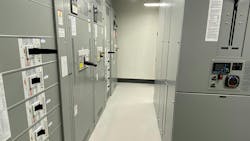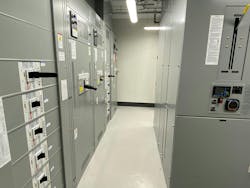Practically Speaking: Condition Confusion
When determining the minimum working space depth required between the 480V equipment on the left side of the aisle to the 480V equipment on the right side, which, if any, of the three conditions specified in Table 110.26(A)(1) apply to this installation as shown?
There seems to be some confusion or significantly differing interpretations about this topic. Some Code users say none of the conditions are applicable here, since there are no exposed live parts and Conditions 1, 2, and 3 each include exposed live parts on at least one side of the working space. I understand that interpretation, but that may also be problematic, since it could lead one to believe that no working space depth is required at all here because none of the conditions apply.
I have always explained the working space depth requirements this way. If any of the three conditions specified in Table 110.26(A)(1) could exist at any time during the life of this installation, then those conditions must be applied when determining the minimum space required between equipment. For example, if the covers are removed for servicing or testing of the equipment on the left side, then Condition 2 would be applicable, since there would be exposed live parts on the left side and grounded parts on the right side. This condition would require a minimum depth of 3 ft-6 in. as measured from the exposed live parts on the left side to the grounded metal enclosure covers on the right side. If covers were simultaneously removed from the equipment on the left side and the equipment on the ride side, then both Conditions 2 and 3 would also exist simultaneously — as there would be exposed live parts and grounded parts on both sides of the working space.
Condition 3 requires a minimum depth of 4 ft as measured between the exposed live parts on each side of the working space. Keep in mind the exposed live parts can sometimes be recessed deep into the enclosure, leading to the potential of having less than 3 ft between the equipment covers if we only measured from live part to live part. That could be a real problem.
Since both Condition 2 and 3 could exist here, the equipment should be installed in a manner that would provide the minimum required spacing between equipment when either condition is applied. Thankfully, there was some Public Input submitted to help clarify these requirements for 2026. As always, I suggest having a discussion with your AHJ to make sure you are both on the same page.
About the Author

Russ LeBlanc
Owner
Russ started in the electrical trade as an apprentice in 1985. He worked his way up to become a Journeyman Electrician and then eventually became a Master Electrician and Licensed Construction Supervisor. In 1999 Russ become an Electrical Instructor for The Peterson School of Engineering in Massachusetts where he developed his passion for teaching, and quickly became Department Head of Electrical Instruction. Russ has taught thousands of apprentices, electricians, engineers, inspectors, and other electrical professionals during his career as an instructor. He continues to provide electrical professionals with Electrical Code seminars, Arc-Flash Awareness training seminars and educational material through his LeBlanc Consulting Services in North Reading, MA whose specialty is educating electricians. He has been an active member of the NFPA Electrical Section and has authored hundreds of National Electrical Code proposals and comments which have become Code rules to improve the safety for the electrical industry. Russ is also an IAEI certified Electrical Inspector.
Please visit www.russleblanc.net for more information.

